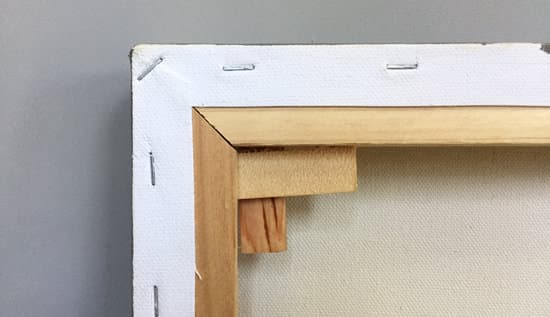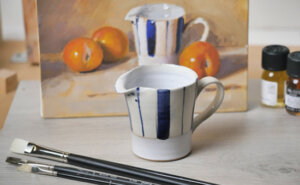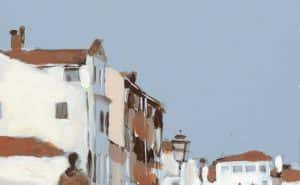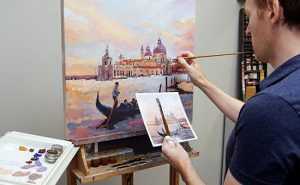
Off the peg or bespoke? The dilemmas of a modern man.
Choosing a canvas is much like deciding between Savile Row, the high street or knitting your own!
With Bespoke, you get:
Neat edges on the back, staple-free sides, a choice of fabric, a choice of finish (unprimed, sized, oil-primed) an exact choice of size, a choice of stretcher bar thickness and a skilled craftsman making it for you, all coming with a premium price tag.
High street, you get:
Neat edges on the back, less robust stretcher bars, not as heavyweight canvas, machine-made but a very reasonable bill.
Knitting your own:
It can be a bit of a headache! But you do get a choice of fabric, choice of size, choice of the stretcher bar, and it’s a very economical way to achieve what you want if working on a lot of canvases the same size. Huge flexibility in finish mixed with the glow of satisfaction when stretching your own canvas…
Bespoke gives you a huge range of choice to suit your own quirks and style of painting.
Like a thin-edged frame with a rough weave? No problem, or maybe a super long thin canvas with a fine surface? You’ve got it.
Going bespoke can be a joy, but I have been through many suppliers with a huge variety of ups and downs. From Chinese import stretcher bars that curve like a banana to straight as a die bars that are just 4mm too deep. Believe me; you can get slightly obsessive about it and the never-ending search for your perfect finish.
The 2 components of a canvas are:
- Stretcher bars – These come in a variety of depths and quality.
- Support – canvas or linen.
Below are my 8 tips if you want to give stretching your own canvas a try:
1. Look for expandable joints.
Often cabinet makers run a sideline in stretcher bars for painting. The majority of the time, although well made, they are not fully air-dried wood and the bars are glued and screwed in a fixed position.
These can look great to start with but leave no option for tightening the canvas over time. Also, they often don’t put in a cross brace on larger stretchers, which can cause the stretcher bars to bend in the middle when pulling hard to achieve a tight canvas.
2. Use the little wedges, even if you don’t know what they are for!
Overtime or if placed in a variety of different temperatures, i.e. a painting placed over a radiator, the wood of the stretcher bar can move and distort slightly. Have you ever noticed how your doors (if wooden) are stiffer to open in the Winter? it’s because the wood expands.
If this happens with your painting, gently tap the wedges (2 per corner) into the grooves at the corners of the stretcher bar, and you will gently push out the bars, thus re-tightening the canvas. You have to be careful with cheaper ready-made canvas’s that still have the wedges because they often don’t fit properly. If you’re too eager with the hammer, it can result in tearing the side of the canvas – yes, I’ve done it a couple of times! Very annoying.
3. Get a sample of the canvas sent through.
Most stretcher bar firms will send you some sample off-cuts of the canvas they hold in stock; it’s well worth it even if they charge for postage because you just can’t get a feel from a photograph.
4. Look for Kiln dried wood.
This is wood that has its moisture removed by drying it in a kiln; this means there will be less room for the wood to move/distort over time.
5. Choose a good weight.
It’s not worth bothering with a canvas under 12oz unless your working really small. 120z means you can pull tight without the fear of ripping.
6. Experiment with priming canvas yourself.
There is something rewarding about sizing and priming a canvas yourself, you value the stretcher more, and you will produce a better painting because of that. If you’re working on a substandard product, you’ll have a tendency to paint with less heart because you place no value on the support.
7. Be prepared for sore fingers.
When stretching canvas yourself, it can be very testing! Trying to pull it tight, handle a staple gun and keeping everything neat can be a juggling act.
Sore fingers and lots of blisters on a big canvas are the norm, wear gloves or start small.
8. Rip your canvas.
Staple a small strip of the canvas you’re going to stretch onto your stretcher bar, then with a pair of stretcher pliers, try to rip it! You’ll be surprised how hard you can pull. Beginners stretching canvas never pull it tight enough; get pumped and rip that bad boy!
You might also like:
1. Getting Started: How a prepared Canvas can drastically improve your painting – An Old Master technique to rapidly improve your paintings
2. Getting Started: A quick way to understand brushes + video – Overview of Acrylic brushes & video on brushes I use for a simple landscape





Thanks for this Will, I really enjoyed reading your tips on using bespoke canvas and had a real good laugh at some of your “tongue in cheek “comments but Oh so true.You have a wonderful sense of humour & way with words. I am an “off the peg” user and will continue to be so. Another very interesting and informative article. Thank You.
Hey Isabel, yes, many hours of sore fingers and odd shaped canvases make an ‘off the peg’ commission a joy!
Glad you enjoyed it,
Will
Love your sharing such valuable knowledge in an excellent way.
Cheers Larry, pleased you’re enjoying the articles.
Will
Thank you Will for sharing with us your knowledge. I would like to learn painting with acrylics. What do you think of painting on card for acrylics? Is it going to last or should I invest in canvases? What are the pros and cons? I hope I do not ask a question which you have already covered. Many thanks!
Hi Victoria,
If you paint on thick card it can work quite well, one of my old tutors used to have us gesso cardboard boxes and use these as impromptu canvas, you’ll get a feel for painting and working on a hard surface, the only thing that will be harder is using watery washes, as the canvas absorbs the moisture as you work and the thin washes soak in. On a harder surface they have the tendency to run off.
Cheers,
Will
Thank you Will. Now I understand why canvas are better than card because of water absorption. As a complete beginner I would not be able to work fast so probably canvas would be better for a start but I have already bought an acrylics pad so will have to practice on it and then buy canvas. Victoria
Good one Victoria, have a go on the acrylic pad and see how you get on.
Cheers,
Will
Hi Will,
I’m a newcomer to the site (just came across it today), but I’ve already worked my way through a dozen articles. You have a knack for explaining the arcane in layman’s terms. The hallmark of a good teacher!
I’d like to ask for your opinion on the necessity to use gesso instead of regular interior latex paint. I’ve used both, and have found the results to be different only in terms of cost (interior paint being vastly less expensive). In practice though, I’ve only used the interior paint on non-flexible surfaces, such as boards.
Online opinion seems to be divided between those who believe (or cite their university professor’s belief) that interior paint is fine and that the “gesso-ites” are just snobs, and those who describe the superior flexibility of gesso on canvas.
So I’m wondering, is using latex paint begging to have a cracked painting if it should ever be rolled?
On a side note, I am currently living in Beijing (just a stone’s throw from the China Academy of Fine Art). Across the street from that is a conglomeration of art supply shops which are stocked with an incredible range of items at an incredible range of prices. Some of it is not to be bothered with. 170 mL tubes of paint for the equivalent of $1.5 USD, paint brushes that fall apart if you touch them, and dangerous-looking tubes of poorly identified liquids. But other items are practically a steal! I have stocked up my painting cabinet for years to come!
(The eventuality of pulling my paintings off and rolling them up for the flight home a few years from now is the real reason I’m asking about the gesso.)
Cheers,
Jack
Hi Jack,
Pleased you’ve been enjoying the articles, to answer your question:
Is using latex paint begging to have a cracked painting if it should ever be rolled?
It shouldn’t really give you a cracked painting if it has a high latex content, but it’s hard to give an exact yes or no due to the huge variety in quality with different brands.
Cheers,
Will
Hi Will,
I really like all art lessons and i really thank you for sharing with us your knowledge.
YOU ARE AWESOME
Hi Will,
I noticed above you’d mentioned writing about your choices for art students. I didn’t find the post on your site? I teach Applied art to Middle and high school. Currently they use really cheap acrylic paint, I believe by Crayola or something cheap like that. Can you recommend acrylic I can buy in larger sizes or even tubes that will be a bit better in quality? Thanks so much.
Hi Summre, any student quality paint from an art brand (such as Winsor & Newton, Daler Rowney etc) will give you a good paint to work with, I would try to stretch the budget to an artist quality white as this will give you the most bang for your buck in terms of opacity of the paint mixes.
Cheers,
Will
Great information, Will! I recently bought some expensive bespoke prestretched linen canvases that have been sized with rabbit skin glue and primed with lead white. I see that on the back of the canvases the sizing and primer did not extend to the ends of the linen. This left the linen floppy and it’s rolling up. Also, there are many loose threads. The fraying is quite serious. I’m concerned about the fraying continuing and also the look of it doesn’t seem professional. What is traditionally done with linen? In the past I’ve always used cotton duck canvas that was gessoed to the edges so it was stiff and no fraying. Thank you for your advice!
Hi Susan, the canvas is usually stapled neatly on the side of back of the canvas. There can be odd strands of fibre depending on the manufacturer, and these can be left as raw linen/canvas with only the main surface and edged of the canvas sized and primed.
Hope this helps,
Cheers,
Will
Hi Will. U can stay in my guest house on the farm for FREE when you come to SA! I am so grateful to you and to have found your mindblowingly good tutorials… Have been studying Fine Art by correspondence, and all the technical stuff is for us to find out ourselves. These days breaking the rules and doing thing differently is cool, but at the end of last year I have found myself wanting to relearn everything “properly” and then mix things up. Have discovered some things that I do completely “wrongly”, such as I prime whatever surface with normal cheap PVA paint, sanding in btw layers and changing direction with each layer, and THEN sizing with cheap woodglue mixed with water. I loved the smooth non-porous surface (for oils)… but often struggled with the apprearance of linseed oil glazes ending up too glossy. I will try the porous surface of sizing first, followed by priming, now… I also read with interest the info on different gessos, some with a smoother finish. In one painting I did recently I worked in very thin layers of oil, imitating watercolours, but the canvas type priming finish on my MDF board showed through and really was far too hard and heavy for my painting technique. I suppose I should try a harder gesso, maybe use a sponge roller to apply (iso a brush) and sand more between layers… What do you think? Also: How do you stop yourself from overworking any area when painting? To get a more expressive feel? Just looking at your cherry tutorial, I love the “casualness” in which you treat every aspect of the painting, Does that come with practice and constant awareness? I find I have to concentrate very hard to maintain that, and when my mind wanders I can find myself returning to colouring-in mode/painting-a-wall mode… Lastly: how would one prepare a canvas/mdf board for overpainting that already has an oil painting on it? I have sanded some mdf board with paintings on that I want to overwork, but now realise that I must have sanded through the (incorrect sequence) sizing in places… And how would one do it differently for an image one wants to keep, and just rework, and an image one wants to overwork completely with something else? And how does oil paint affect an mdf board if there is no sizing to “protect” the mdf?… MY offer at the beginning stands!!! Best Regards, Erika
Hi Erika, pleased you’ve been enjoying the lessons and thanks for the kind offer!
Creating a more impressionistic style in your works comes from practice and not trying to focus on the essentials in a scene that capture the subject.
For preparing MDF for an oil painting, you would ideally seal the surface with a sealant like GAC100 (from Golden Artist Colors) or Archival PVA from Gamblin and then apply a gesso.
The sealant will prevent the oil from seeping through into the board and stop any chemicals from the MDF board affecting the oil.
For a gesso if you’re working predominantly in oils using a quick drying oil ground like the Gamblin Alkyd Oil Ground can give you a good surface for oil.
Hope this helps,
Cheers,
Will
Thanks for your reply & help, Will! Everything you write is of huge benefit!
May I also ask you on what kind of surface & surface prep you would work if you were working very thinly in oils (imitating watercolours – to some degree)?
And how would you prepare a surface that has an oil painting on it that you want to OVERWORK with a new work, also in oils?
Many thanks, Erika (South Africa)
Hi Erika,
I would prep the painting the same way as with any oil painting with a couple of gesso layers over a canvas that has been sealed (either traditionally with rabbit skin glue or more commonly now an archival PVA) You can change the absorbency of the gesso by adding in more chalk to make it more absorbent but with a fine weave pre-primed oil canvas you would still be able to achieve multiple thin layers.
Overpainting over a painting, you can read about it here in relation to an acrylic painting, but the same principles apply. It’s just tricky with the absorbency because of the lack of tooth in the canvas.
Hope this helps,
Cheers,
Will
Will, what do you think of painting on canvas stretched on a plank and only after completed work, fixed it to a rack?
I think working with the brush or the knife is more enjoyable because the canvas does not behave like a drum membrane.
You can stretch canvas over board, or attach canvas to a board to give you a solid surface to paint against.
Cheers,
Will
Hi Will, great info on here, thank you very much. I am starting to paint on canvas, but I am looking for a better quality canvas now. Where do you recommend to buy the canvases ? also my paintings are abstract acrylic, I really like expressing myself with this method, but my husband thinks it looks like our 1-year-old baby has splattered a bit of paint around. My other question is, in your opinion how abstract can a painting be before it turns into a messy disaster ?
Hi Joanne, nice to hear from you, you can buy rolls of canvas and linen from most art supplies stores. They range in price from manufacturer to manufacturer. Often the brands own range can give you a good price to quality standard for larger scale paintings.
Will
Hi Will – I love watching your videos!
Can you advise on whether to frame or not frame a canvas….is it worth spending the extra money on a floating canvas (which is usually 4 times as much as your canvas and paint supplies!) and if you are going to display at an exhibition, what kind of canvas would you recommend (depth, quality etc,?) Thanks!
Carol
Hi Carol, framing is a personal choice depending on the subject, style and feel you’re after in the painting. Usually, more traditional thinner stretcher bars are framed and more contemporary box canvases can be displayed unframed. But this is a very general statement, I’d try getting a small frame that would fit a size canvas you usually work on and then try a few paintings within in. Then you can judge mores easily if you prefer the framed or unframed look.
Cheers,
Will
Hi Will,
Thank you for this post, it is amazing, your website has the answer to every question related to art. :)
Recently I have found a pre-stretched and triple primed 10oz canvas, I haven’t tried it yet because you suggested it was not worth to work on less than 12oz canvases. But it is a quite prestigious brand, and as I see you mention this 12oz limit with hand-stretched canvases. So, I would like to ask your opinion about cheaper, 10oz pre-stretched and primed canvases. Do they worth?
Many thanks,
Dora
Hi Dora, a 10oz canvas is great for smaller pieces, personally, I find them more tricky when they get larger as the canvas isn’t as tough for my style of painting (quite stiff brushes and rapid brushmarks). If you are painting small and paint with a more flowing line a 10oz would be fine.
Cheers,
Will
Thank you, Will, I really appreciate these little tricks. :)
Just complete my first portrait, following your ‘free’ on-line notes and instruction. Quite happy with first attempt. Could send a photograph??
Hi Denis, you can send it through to my email on the contact page
Cheers,
Will
Hi Will,
You are my go to Authority on everything, I find your tutorials incredibly beneficial and inspirational, many thanks for your great generosity. May I ask you a question, I have bought ready, primed canvass for the pet portraits I have been commissioned to paint and then spray varnish them after leaving them to dry for 48hrs on completion. Should I be looking to put a stabilising coat underneath the varnish spray? Many thanks Ellie
Hi Ellie, if the varnish is a removable varnish I tend to apply an isolation coat first and then a layer of varnish.
Cheers,
Will